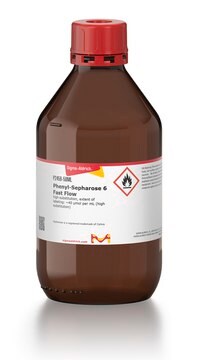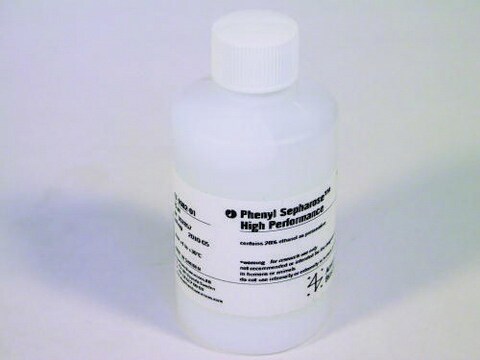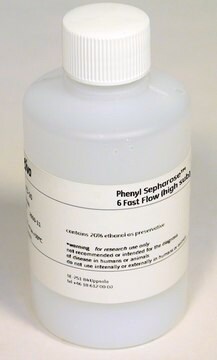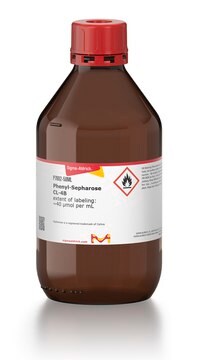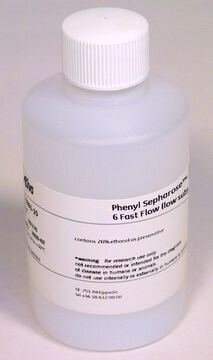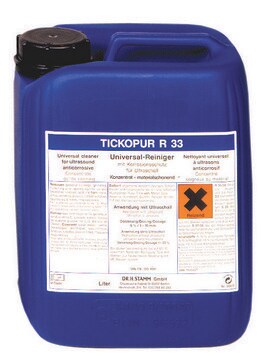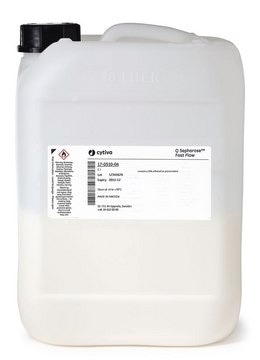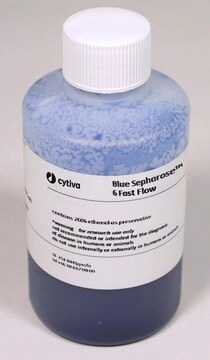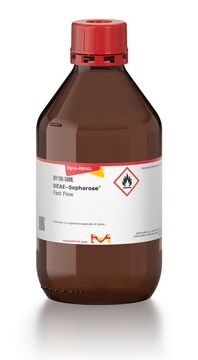P2334
Phenyl-Sepharose 6 Fast Flow
low substitution, extent of labeling: ~20 μmol per mL
Synonyme(s) :
Phenyl-Agarose
Se connecterpour consulter vos tarifs contractuels et ceux de votre entreprise/organisme
About This Item
Produits recommandés
Niveau de qualité
Forme
suspension
Ampleur du marquage
~20 μmol per mL
Matrice
agarose, 6% crosslinked
Activation de la matrice
epichlorohydrin
Fixation de matrice
ether
Espaceur de matrice
3 atoms
Taille des particules
45-165 μm
Capacité
~14 mg/mL binding capacity (BSA)(lineal flow rate of 100 cm/hr)
Température de stockage
2-8°C
Vous recherchez des produits similaires ? Visite Guide de comparaison des produits
Description générale
P2334-200ml′s updated product number is GE17-0965-05
Application
Phenyl [YM="Sepharose"] is used in protein chromatography, affinity chromatography, hydrophobic interaction media, resins and separation media. Phenyl Sepharose™ has been used in studies that contributed to improving industrial applications in additives in detergents and feed industries. Phenyl sepharose has also been used to study microbial communities inhabiting hypersaline environments.
Forme physique
Suspension dans 20% d′éthanol
aqueous ethanol suspension
Informations légales
Sepharose is a trademark of Cytiva
Remplacé(e)(s) par
Réf. du produit
Description
Tarif
Mention d'avertissement
Warning
Mentions de danger
Conseils de prudence
Classification des risques
Flam. Liq. 3
Code de la classe de stockage
3 - Flammable liquids
Classe de danger pour l'eau (WGK)
WGK 3
Point d'éclair (°F)
95.0 °F
Point d'éclair (°C)
35 °C
Faites votre choix parmi les versions les plus récentes :
Déjà en possession de ce produit ?
Retrouvez la documentation relative aux produits que vous avez récemment achetés dans la Bibliothèque de documents.
Les clients ont également consulté
P D Zschocke et al.
European journal of biochemistry, 213(1), 263-269 (1993-04-01)
A purification procedure for guanylate kinase from pig brain has been developed consisting of ammonium sulfate precipitation and heptane extraction of the crude extract, hydrophobic-interaction chromatography, affinity chromatography and chromatofocussing. From 1.75 kg pig brain, 1.2 mg enzyme was isolated
J L Blank et al.
The Journal of biological chemistry, 268(33), 25184-25191 (1993-11-25)
We report the purification from bovine brain cytosol of a 110-kDa phosphoinositide-specific phospholipase C (PLC-110) that was markedly stimulated by G-protein beta gamma-subunits. The enzyme was purified approximately 2000-fold with a yield of 4%. On the basis of size and
Agnes Marot-Leblond et al.
Journal of clinical microbiology, 44(1), 138-142 (2006-01-05)
Cell components of the dimorphic pathogenic fungus Candida dubliniensis were used to prepare monoclonal antibodies (MAbs). One MAb, designated 12F7-F2, was shown by indirect immunofluorescence to be specific for a surface antigen of Candida dubliniensis yeast cells. No reactivity was
Jace L Fogle et al.
Journal of chromatography. A, 1121(2), 209-218 (2006-05-13)
Amide hydrogen-deuterium exchange labeling has been used to study the effects of salt and protein loading on alpha-lactalbumin (BLA) stability during hydrophobic interaction chromatography (HIC). Stability in the adsorbed phase increased dramatically with increasing loading, and unfolding was nearly undetectable
Simona Lobasso et al.
Photochemistry and photobiology, 88(3), 690-700 (2012-01-18)
We have isolated and characterized the light-driven proton pump Bop I from the ultrathin square archaeon Haloquadratum walsbyi, the most abundant component of the dense microbial community inhabiting hypersaline environments. The disruption of cells by hypo-osmotic shock yielded Bop I
Notre équipe de scientifiques dispose d'une expérience dans tous les secteurs de la recherche, notamment en sciences de la vie, science des matériaux, synthèse chimique, chromatographie, analyse et dans de nombreux autres domaines..
Contacter notre Service technique